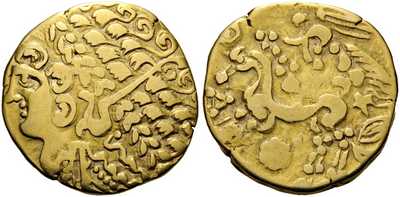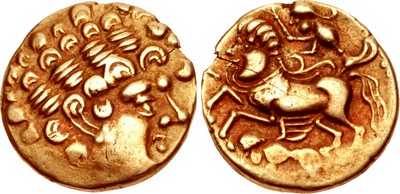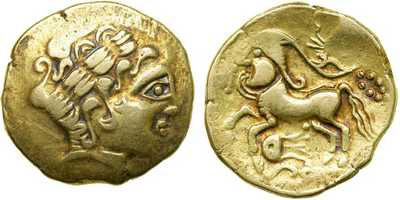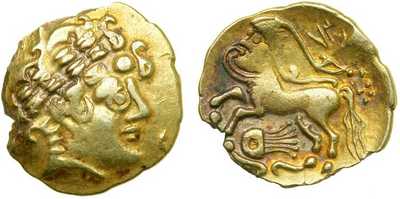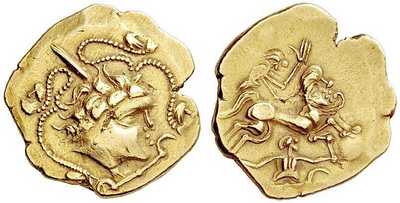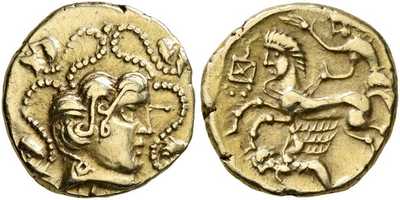| Back to First Generation Coins (c. 275 BC to c. 200 BC) | This page is part of the article Getting Started with Celtic Coins | Forward to Third Generation Coins (c. 125 BC to c. 50 BC) |
It is in this period that the Celts from Northern Gaul started to experiment with the design of the Philippus, although they didn’t drift very far from the original. Abstraction started in this period, and the Celts started to change some of the design elements. The horses pulling the chariot got replaced by a single horse, and the Treveri and Armoricans decided to give it a human head. The legend below the horse became a free-form design element.
On the whole though, the coins of this period still resemble the original Philippus. We’ll take a look at two of the major coin series from this period:
Gallo-Belgic A
Around 175 BC, the Ambiani and the Bellovaci from Belgic Gaul (north east Gaul) replaced all their coins with a new type which we call Gallo-Belgic A, which they minted until about 125 BC. These coins were partly minted for export to Britain to pay for mercenaries to help in the ongoing wars against the Germanic tribes, so they had to be staters like the original Philippus. The Philippus imitations in this area were half staters by this stage, so new coins were needed.
The Ambiani are thought to have minted Gallo-Belgic Aa, and the Bellovaci are thought to have minted Gallo-Belgic Ab (although this appears to be disputed by French numismatists who assign both types to the Ambiani).
Photo Copyright CGB Numismatique Paris
This massive series of coins was based on a number of earlier coins. The head and the hair on the obverse were based on coins like the “Bearded Head” Philippus imitations:
Photo Copyright Classical Numismatic Group, LLC
The hair bar was inspired by coins from Tarentum featuring Hera on the obverse (Scheers, “La Gaule Belgique - Traité De Numismatique Celtique”):
The cloak appears to be a local innovation (Sills, “Gaulish and Early British Gold Coinage”). Of course, it’s always possible that the hair bar was a local innovation as well. There’s no reason to assume every little detail had to be copied from another coin.
The reverse was based on the Soy Stater’s reverse. While it looks like any Philippus could have inspired the reverse, this type has the doubled wheel which is a feature of Gallo-Belgic A.
Photo Copyright Leu Numismatik AG
Gallo-Belgic A (both Aa and Ab) are found in large quantities in Britain, where they continued to circulate long after they had been replaced in Gaul. In fact, they were still circulating 75-100 years after they came to Britain, and as a result are often found in poor condition, either being badly worn or having been clipped or “sweated” (abraded to release gold dust) to bring the weight down to match the later coins imported from Gaul.
Sometime around 120 BC, the Gallo-Belgic A coins were recalled in Gaul and reminted, replaced with a series of coins we call Gallo-Belgic C. In parallel with these, another family of coins called the Eye staters appeared. We’ll cover both of these later in the “Third Generation Coins” section.
Further Reading
- “Gaulish and Early British Gold Coinage” by Dr. John Sills
Coins of the Treveri and Armorican Tribes
Coins of the Treveri
The second century BC saw a distinctive range of coins based on the Philippus from the Treveri (or Treviri) in Eastern Gaul (western Germany). These distinctive coins, featuring a human headed horse on the reverse, appear to have been relatively short lived as only four variations are known. The first two are found in both stater and quarter stater formats, but the last two are found as quarters only.
Photo Copyright American Numismatic Society (CC BY-NC 4.0)
Photo Copyright Classical Numismatic Group, LLC
Photo Copyright Ira & Larry Goldberg
Photo Copyright Ira & Larry Goldberg
Photo Copyright Leu Numismatik AG
Copyright Unknown
Coins of the Armorican Tribes
What’s particularly interesting about these coins is that an almost identical set of coins can be found in Armorica, which is on the west coast of France.
They first seem to appear there from a tribe called the Aulerci Cenomani, but quickly spread to many of the neighbouring tribes. It’s not clear how the coins suddenly appeared on the other side of the country, but the two main theories are:
- The Treveri split into two tribes with one of them emigrating to Armorica
- The coins assigned to the Treveri actually came from another tribe who were forced out by the Treveri, and who then moved to Armorica
The Treveri coins set the style in Armorica from the second century BC until the Celts stopped minting coins. The following are some of the Treveri derivatives from the Armorican tribes. Some of these coins have a low weight and are not made from gold, suggesting that they were perhaps third generation rather than second generation.
Aulerci Cenomani
This tribe replaced the winged figure beneath the horse with a prone figure.
Photo Copyright Numismatica Ars Classica NAC AG, Auction 100, Lot 1001
Photo Copyright Leu Numismatik AG
Aulerci Diablintes
This tribe replaced the winged figure beneath the horse with a hippocamp (or a seahorse).
Photo Copyright Numismatica Genevensis SA
Baiocasses
This tribe replaced the winged figure beneath the horse with a boar, and also radically changed the head on the obverse.
Photo Copyright Leu Numismatik AG
Based on the low weight and the metal, this might be a third generation coin.
Namnetes
This tribe replaced the winged figure beneath the horse with a figure with raised arms, and also radically changed the head on the obverse.
Photo Copyright Numismatica Ars Classica NAC AG, Auction 54, Lot 1
Osismii
This tribe replaced the winged figure beneath the horse with a bull over Δ shape, and also radically changed the head on the obverse.
Photo Copyright CGB Numismatique Paris
Photo Copyright CGB Numismatique Paris
Based on the low weights and the metal, these might be third generation coins.
Pictones
This tribe replaced the winged figure beneath the horse with a large hand, and also radically changed the head on the obverse.
Photo Copyright Fritz Rudolf Künker GmbH & Co. KG, Osnabrück; Lübke & Wiedemann KG, Leonberg
Based on the low weight and the metal, this might be a third generation coin.
Veneti
This tribe continued to use a winged figure beneath the horse, but radically changed the head on the obverse.
Photo Copyright CGB Numismatique Paris
Photo Copyright Leu Numismatik AG
Article Navigation
| Back to First Generation Coins (c. 275 BC to c. 200 BC) | Up to The Celts from Northern Gaul | Forward to Third Generation Coins (c. 125 BC to c. 50 BC) |

